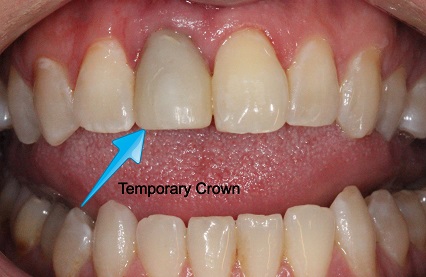When you go to your dentist to repair a damaged or decaying tooth, the dentist may make a temporary crown to be placed over the damaged tooth as a placeholder until a permanent crown is made in the dental laboratory. One issue you face might be what to do if the temporary crown fell off. A temporary restoration is usually made of acrylic, and serves to protect the tooth from plaque and germ contamination. Unfortunately, they sometimes fall off before you receive your permanent crown.

What You Should Do If Temporary Crown Fell Off
1. Remove the Crown
The first thing you will want to do is to remove the crown from your mouth, lest you end up swallowing it, or worse inhaling it into your lungs.
2. Call Your Dentist
Make a call to your dentist letting him know that your temporary crown fell off, and you will want to be able to give them as many details as possible. The dentist may advise you to try a self-repair using a temporary dental glue before your next appointment.
3. Examine the Tooth and Crown
If the temporary crown contains part of your tooth, or your tooth has become fractured, you will need to see the dentist right away. If the crown looks hollow, or it has a metal rod that serves as an anchor to your tooth, there may be a possibility for you to temporarily glue it back in yourself. Still, you have to ask your dentist if doing so is okay.
4. Temporarily Repair the Tooth
In the event that you are able to glue it back in, go to your local pharmacy, and purchase some good dental glue. Ask your dentist or pharmacist for recommendations. When you are ready to temporarily repair the tooth, take a toothbrush and gently clean both the tooth and the crown, making sure all food particles have been removed. Then dry the crown and the tooth as dry as you can get them before applying the dental glue. Remember to follow any instructions on the dental glue label, and proceed to make the repair.
5. Be Careful What You Chew
You will have to be careful of what you chew on, no gum or taffy, to ensure the temporary crown doesn't fall off again. What is important to remember is that the dental glue is not as strong as what your dentist will use when they make a more permanent repair.
Possible Causes Why Your Temporary Crown Fell Off
Most dental repair work, including temporary crowns, is not designed last forever. Problems can and do occur with either the underlying tooth, or with crown itself. For example, temporary crowns that anchor to the underlying tooth are more prone to fall out. It depends on the quality and amount of tooth structure that is available to the dentist. Other failures may include:
- Trauma: Trauma may occur from a sudden impact that jostles the crown’s metal anchor loose from its mooring in the tooth, such as a sports injury. It is also sometimes loosened by hard or chewy food. This kind of trauma can also chip off a piece of the crown, or damage the underlying tooth by fracturing it.
- Heavy grinding: If you tend to clench or grind your teeth a lot, it could eventually loosen or force the crown to become unglued, causing it to fall off.
- Decay: The part of your tooth where it meets the temporary crown is vulnerable to decay. Proper dental hygiene is even more important when you have a crown to help prevent further decay of the supporting tooth. If a gap is allowed to form, it can spread very quickly under a crown and weaken the foundation leading to failure of the crown.
- Aging: If a temporary crown fell off, it might be due to its age. The age of a crown will eventually and gradually deteriorate the cement that holds the crown in place over a long period of time. It is usually remedied by re- cementing the crown back in place as long as there is no other damage.
Any of these issues may require further treatment by your dentist. If the tooth becomes too decayed, or a piece of the tooth is broken off or otherwise fractured, it may have to be replaced. The same holds true if the crown repeatedly falls off, suggesting the fit is no longer adequate, or the foundation is too weak to support a crown.
Aftercare for Crowns
The proper aftercare for crowns is important, whether you have a temporary crown or a permanently tailored crown from the dental laboratory. The following recommendations are:
- Avoid eating for 30 minutes or more after you have had a crown placed on your tooth. This will give the cement time to harden.
- If you have a temporary crown, do not consume hard or chewy foods, including gum. When you do get a permanent crown, avoid these food items for at least 24 hours to allow for the cement to cure.
- Avoid using the side of your mouth that has a temporary crown by shifting the bulk of chewing to the other side.
- Remember to use proper dental hygiene after meals and at bedtime. However, if you have a temporary crown, try not to brush or floss too hard.
- Be sure to keep your appointment for a permanent crown, and remember to schedule a six- month checkup with your dentist after the placement of a permanent crown.
